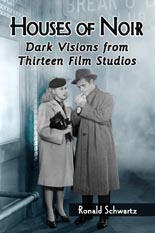
 One can appreciation the idea behind Ronald Schwartz’s Houses of Noir: Dark Visions from Thirteen Film Studios without doing the same for the execution.
One can appreciation the idea behind Ronald Schwartz’s Houses of Noir: Dark Visions from Thirteen Film Studios without doing the same for the execution.
That idea is simple: Pick the best example of film noir from each studio in play of that golden era, and discuss it. Granted, this mean the work is driven by the author’s subjectivity — no problem there. What ultimately makes the McFarland & Company paperback lacking of substance is what passes for discussion and criticism.
Schwartz, a New York film professor, has great taste. For his baker’s dozen of bullets, broads and blackmail, he’s selected some excellent movies, including Charles Vidor’s Gilda, starring Rita Hayworth at her va-va-voomiest; Edgar G. Ulmer’s cheapie Detour; and Billy Wilder’s Double Indemnity, certifiable classic.
I hope you’ve seen them, because should you choose to read the book, you’re given lengthy, detailed, beat-by-beat plot summaries of each. What’s the point? Following each summary is a list of the film’s main actors, each of whom is presented with a list of other notable titles from his or her filmography. What’s the point? More futility lay ahead, as Schwartz closes each chapter by describing each photograph. What’s the point?
Far better books from earlier this year tackle the same subject. Spend your ever-valuable time and money on David J. Hogan’s Film Noir FAQ or John Grant’s A Comprehensive Encyclopedia of Film Noir instead. —Rod Lott
